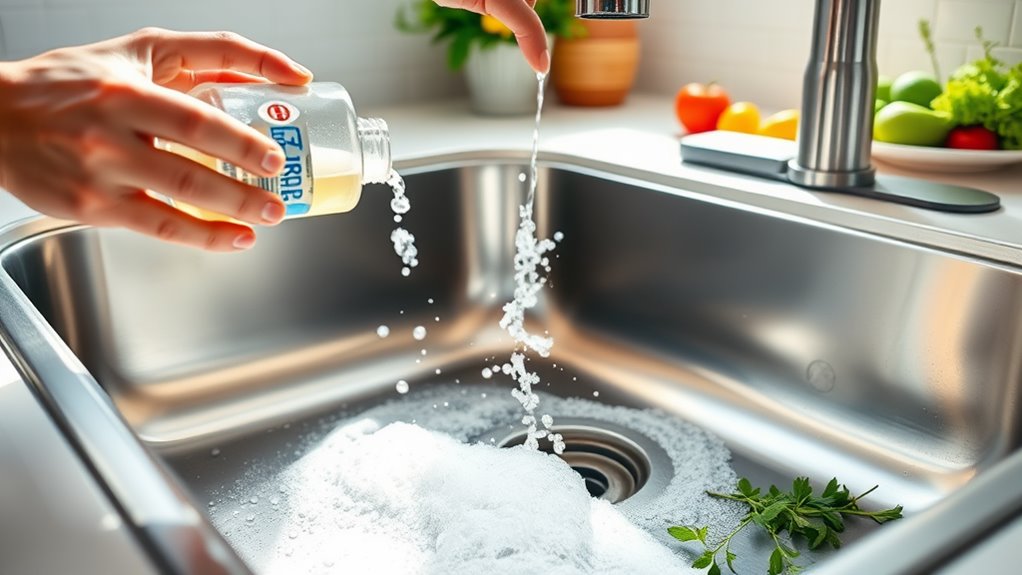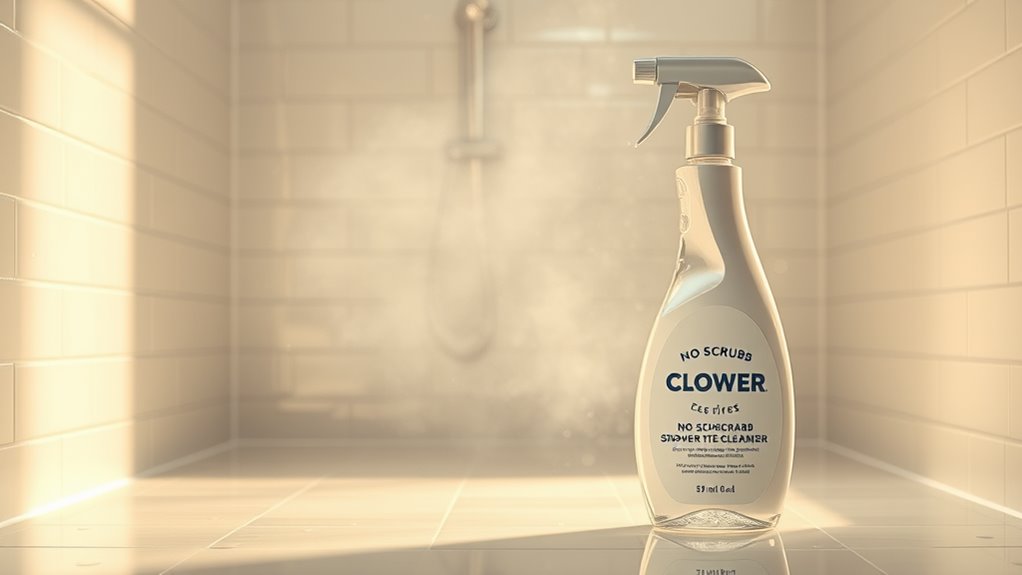Clean Your Kitchen Drain With This Simple No-Chemical Trick
To clean your kitchen drain with this simple no-chemical trick, grab baking soda and white vinegar. Pour 1 cup of baking soda down the drain, followed by a quick pour of 1 cup of vinegar mixed with a dash of water. Let it sit for 15 to 30 minutes. Then, rinse it with boiling water to flush away residue and odors. This method keeps your drain fresh and functional—discover more tips to prevent future clogs and maintain your kitchen’s cleanliness.
Key Takeaways
- Use a mixture of 1 cup baking soda and 1 cup vinegar to effectively clean your kitchen drain without chemicals.
- Pour the baking soda directly into the drain, followed by the vinegar mixture for a powerful fizzing reaction.
- Let the mixture sit for 15 to 30 minutes to break down grease and debris before rinsing.
- Rinse the drain with boiling water to wash away loosened gunk and odors, enhancing cleanliness.
- Regularly maintain your drain by cleaning monthly and avoiding dumping oils or fats down the sink.
The Importance of a Clean Kitchen Drain
While you mightn’t think about it often, a clean kitchen drain is essential for maintaining a healthy home. A clogged or dirty drain can lead to unpleasant odors, attracting pests and fostering bacteria. Regular drain cleaning prevents these issues, ensuring your kitchen remains a safe space for food preparation. Furthermore, a clean drain promotes proper water flow, reducing the risk of overflows and costly plumbing repairs. By mastering the art of drain cleaning, you’ll not only enhance your kitchen’s functionality but also contribute to your family’s well-being. Additionally, using natural ingredients like baking soda and vinegar can effectively unclog and clean your drains without harsh chemicals. Eco-friendly all-purpose cleaners can also be beneficial for maintaining cleanliness in your kitchen. Proper disinfecting techniques can further enhance your drain cleaning routine, promoting a healthier home environment. Using a combination of vinegar and baking soda can create a powerful cleaning reaction that helps break down buildup in your drains. Using eco-friendly cleaners not only supports a healthier household but also reduces environmental impact. Prioritize your kitchen drain’s cleanliness, and enjoy the benefits of a healthier home environment.
Gather Your Supplies
Before you plunge into cleaning your kitchen drain, it’s essential to gather the right supplies.
Having everything at your fingertips not only streamlines the process but also guarantees you tackle the task efficiently.
Here’s what you need:
-
Baking Soda – This powerhouse ingredient will help break down stubborn residues and odors. Additionally, baking soda is also a key component in various eco-friendly cleaners you can make at home.
-
White Vinegar – It reacts with baking soda to create fizzing action that loosens debris. This reaction is similar to the cleaning solution made from vinegar and water.
-
Boiling Water – This is your final touch, washing away any lingering gunk and leaving your drain fresh.
Additionally, using natural ingredients like baking soda and vinegar can help maintain a chemical-free kitchen. Incorporating essential oils can also enhance the cleaning experience with pleasant scents. Regularly using affordable cleaning solutions can further prevent build-up in your drains.
With these supplies ready, you’re set to transform that troublesome drain into a clean, functional space.
Mastering this simple technique will keep your kitchen in top shape, enhancing your cooking and cleaning experience.
Prepare the Baking Soda and Vinegar Mixture
To clean your kitchen drain effectively, you’ll need baking soda and vinegar. The right mixing ratio plays an essential role in maximizing their cleaning power, so let’s break that down. Once you have your mixture ready, you’ll want to apply it correctly for the best results. Additionally, using natural cleaning alternatives can help reduce harmful chemicals in your home. Using these affordable cleaning solutions can also save you money while keeping your kitchen fresh and clean. Vinegar, known for its versatility as a cleaner, can effectively break down grease and grime in your drain, making it an excellent choice for eco-friendly cleaning. For enhanced effectiveness, consider adding essential oils to your mixture, which can provide additional antimicrobial properties.
Essential Ingredients Needed
Cleaning your kitchen drain can be a breeze with just a couple of essential ingredients: baking soda and vinegar. These common household items work together to break down clogs and eliminate odors without harsh chemicals.
Gather the following:
- Baking Soda: This fine, white powder is a powerful deodorizer and abrasive cleaner.
- White Vinegar: Its acetic acid content helps dissolve buildup and grease, making it an excellent ally for drain cleaning.
- Hot Water: Boiling water helps activate the ingredients and flush out the debris effectively.
With these three essentials at hand, you’re well on your way to mastering the art of natural drain cleaning.
Embrace this simple yet effective method, and enjoy a fresher, cleaner kitchen drain!
Mixing Ratios Explained
Creating the perfect baking soda and vinegar mixture is straightforward and only requires a few key ratios. Start with a 1:1 ratio of baking soda to vinegar for maximum effectiveness. Typically, you’ll want to use about one cup of baking soda followed by one cup of vinegar.
This balance guarantees a vigorous reaction that can effectively break down grease and grime in your kitchen drain. If you’re tackling a particularly stubborn clog, you might increase the baking soda to two cups and follow with one cup of vinegar.
Always remember to pour the baking soda first, then the vinegar, and let the mixture fizz and work its magic. Master these ratios, and you’ll be well on your way to a cleaner drain.
Application Techniques for Effectiveness
Start by gathering your materials: baking soda, vinegar, and a measuring cup. You’ll need these to create an effective cleaning solution for your kitchen drain.
Follow these steps for ideal results:
-
Measure: Pour 1 cup of baking soda directly into the drain, ensuring it settles in the pipe.
-
Mix: Next, mix 1 cup of vinegar with a dash of water in your measuring cup. This blend will activate the baking soda.
-
Combine: Pour the vinegar mixture into the drain quickly, and watch as it fizzes and bubbles. This reaction helps break down grime and buildup.
Let it sit for about 15 to 30 minutes, then flush with hot water. Your drain will be refreshed and clean!
Pouring the Mixture Into the Drain
Once you’ve prepared your cleaning mixture, it’s time to pour it into the drain.
Position yourself over the sink and carefully begin to pour the mixture. Aim for an even flow to guarantee every part of the drain gets treated.
Don’t rush this step; a steady pour allows the solution to penetrate deeper into the buildup. If you’re using a container, tilt it slightly to control the stream and prevent splashing.
Remember, this mixture is designed to tackle grease and grime effectively, so focus on getting it all in there.
Once you’ve poured the entire batch, take a moment to admire your precision—you’re one step closer to a fresh and clean kitchen drain!
Let It Sit and Work Its Magic
Once you’ve poured the mixture into your drain, it’s time to let it sit and work its magic.
The natural ingredients need a few minutes to break down the buildup effectively.
This pause is essential for achieving a clean and fresh drain.
Natural Ingredients Used
When it comes to cleaning your kitchen drain, natural ingredients can work wonders. You don’t need harsh chemicals to achieve a fresh, clog-free drain.
Instead, harness the power of these simple items from your pantry:
-
Baking Soda: This fine powder acts as an abrasive, breaking down grime and odors.
-
White Vinegar: When combined with baking soda, it creates a fizzy reaction that lifts stubborn debris.
-
Lemon Juice: Its acidity not only helps dissolve build-up but also leaves a revitalizing scent.
Time for Effectiveness
While you’re letting your natural cleaning ingredients do their work, patience is key. After applying your chosen mixture, give it time to penetrate and break down the grime lurking in your kitchen drain.
Typically, letting it sit for about 30 minutes allows the ingredients to dissolve buildup effectively. You might even consider extending this time for stubborn clogs. During this period, avoid running water; it can wash away the cleaning solution before it’s had a chance to work its magic.
Use this waiting time to tackle other kitchen chores or simply relax. When you return, flush the drain with hot water to rinse away any remaining debris. You’ll be amazed at the difference a little patience can make!
Rinse With Hot Water
To keep your kitchen drain flowing smoothly, rinsing it with hot water is essential. This simple step helps dissolve grease and food particles that can lead to clogs.
Here’s how to do it effectively:
-
Boil Water: Start by boiling a kettle or using your stovetop to heat a sufficient amount of water.
-
Pour Slowly: Once boiling, pour the hot water down the drain gradually. This allows it to work its magic on stubborn debris.
-
Repeat: For best results, repeat this process a couple of times, especially if you frequently cook with oils or fats.
Preventative Measures for Future Clogs
Keeping your kitchen drain clear is easier than you think, especially if you implement a few preventative measures.
First, always scrape food scraps into the trash before washing dishes. This simple action reduces debris that could clog your drain.
Next, consider using a sink strainer to catch smaller particles. Regularly flush your drain with hot water to dissolve any grease that may accumulate.
Additionally, avoid pouring oils or fats down the sink; they solidify and cause blockages.
Finally, clean your drain monthly with a mixture of baking soda and vinegar to break down buildup.
By adopting these practices, you’ll not only maintain a clean drain but also extend the life of your plumbing system.
Master these techniques and enjoy a hassle-free kitchen!
Frequently Asked Questions
Can I Use This Method for Bathroom Drains Too?
Absolutely, you can use this method for bathroom drains too. It’s effective in breaking down buildup and odors, ensuring your drains stay clear. Just follow the same steps, and you’ll see great results!
How Often Should I Clean My Kitchen Drain?
You should clean your kitchen drain at least once a month. Regular maintenance prevents buildup, keeps odors at bay, and guarantees efficient drainage. Trust me, staying proactive will save you time and hassle later on.
What Should I Do if the Clog Persists?
If the clog persists, try using a plunger or a plumber’s snake to dislodge the blockage. You might also consider pouring hot water down the drain to break up grease or debris that’s causing issues.
Is This Method Safe for Septic Systems?
Yes, this method’s safe for septic systems. You’ll effectively break down clogs without harmful chemicals. Just guarantee you’re using the right ingredients and following the recommended steps to maintain your system’s health and efficiency.
Can I Substitute Vinegar With Something Else?
You can substitute vinegar with lemon juice or baking soda for similar cleaning effects. Both options are natural and effective, helping to break down buildup while keeping your kitchen environment safe and fresh without harsh chemicals.



